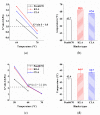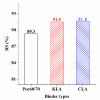Effect of Lignin Modifier on Engineering Performance of Bituminous Binder and Mixture
- PMID: 33805562
- PMCID: PMC8037787
- DOI: 10.3390/polym13071083
Effect of Lignin Modifier on Engineering Performance of Bituminous Binder and Mixture
Abstract
Lignin accounts for approximately 30% of the weight of herbaceous biomass. Utilizing lignin in asphalt pavement industry could enhance the performance of pavement while balancing the construction cost. This study aims to evaluate the feasibility of utilizing lignin as a bitumen performance improver. For this purpose, lignin derived from aspen wood chips (labeled as KL) and corn stalk residues (labeled as CL) were selected to prepare the lignin modified bituminous binder. The properties of the lignin modified binder were investigated through rheological, mechanical and chemical tests. The multiple stress creep recovery (MSCR) test results indicated that adding lignin decreased the Jnr of based binder by a range of 8% to 23% depending on the stress and lignin type. Lignin showed a positive effect on the low temperature performance of asphalt binder, because at -18 °C, KL and CL were able to reduce the stiffness of base binder from 441 MPa to 369 MPa and 378 MPa, respectively. However, lignin was found to deteriorate the fatigue life and workability of base binder up to 30% and 126%. With bituminous mixture, application of lignin modifiers improved the Marshall Stability and moisture resistance of base mixture up to 21% and 13%, respectively. Although, adding lignin modifiers decreased the molecular weight of asphalt binder according to the gel permeation chromatography (GPC) test results. The Fourier-transform infrared spectroscopy (FTIR) test results did not report detectable changes in functional group of based binder.
Keywords: bituminous modifier; chemical analysis; lignin; lignin modified bitumen; mechanical properties; rheological behavior.
Conflict of interest statement
We declare that we do not have any commercial or associative interest that represents a conflict of interest in connection with the work submitted.
Figures














Similar articles
-
Effect of Thermal Oxygen Aging Mode on Rheological Properties and Compatibility of Lignin-Modified Asphalt Binder by Dynamic Shear Rheometer.Polymers (Basel). 2022 Aug 30;14(17):3572. doi: 10.3390/polym14173572. Polymers (Basel). 2022. PMID: 36080649 Free PMC article.
-
Laboratory Investigation of Lignocellulosic Biomass as Performance Improver for Bituminous Materials.Polymers (Basel). 2019 Jul 29;11(8):1253. doi: 10.3390/polym11081253. Polymers (Basel). 2019. PMID: 31362441 Free PMC article.
-
Experimental Investigation on the Use of Selenice Natural Bitumen as an Additive for Pavement Materials.Materials (Basel). 2021 Feb 21;14(4):1023. doi: 10.3390/ma14041023. Materials (Basel). 2021. PMID: 33670058 Free PMC article.
-
Evaluation of the Properties of Asphalt Mixes Modified with Diatomite and Lignin Fiber: A Review.Materials (Basel). 2019 Jan 28;12(3):400. doi: 10.3390/ma12030400. Materials (Basel). 2019. PMID: 30696026 Free PMC article. Review.
-
Radiation and Radical Grafting Compatibilization of Polymers for Improved Bituminous Binders-A Review.Materials (Basel). 2024 Apr 3;17(7):1642. doi: 10.3390/ma17071642. Materials (Basel). 2024. PMID: 38612155 Free PMC article. Review.
Cited by
-
Laboratory Study on the Stiffening Phenomena Caused by Aging and by the Addition of Kraft Lignin at Low Dosages Measured by Physico-Chemical and Rheological Tests on a Soft Bitumen.Materials (Basel). 2025 May 10;18(10):2209. doi: 10.3390/ma18102209. Materials (Basel). 2025. PMID: 40428945 Free PMC article.
-
Ambient-Pressured Acid-Catalysed Ethylene Glycol Organosolv Process: Liquefaction Structure-Activity Relationships from Model Cellulose-Lignin Mixtures to Lignocellulosic Wood Biomass.Polymers (Basel). 2021 Jun 17;13(12):1988. doi: 10.3390/polym13121988. Polymers (Basel). 2021. PMID: 34204467 Free PMC article.
-
Effect of Thermal Oxygen Aging Mode on Rheological Properties and Compatibility of Lignin-Modified Asphalt Binder by Dynamic Shear Rheometer.Polymers (Basel). 2022 Aug 30;14(17):3572. doi: 10.3390/polym14173572. Polymers (Basel). 2022. PMID: 36080649 Free PMC article.
-
Optimizing the Texturing Parameters of Concrete Pavement by Balancing Skid-Resistance Performance and Driving Stability.Materials (Basel). 2021 Oct 15;14(20):6137. doi: 10.3390/ma14206137. Materials (Basel). 2021. PMID: 34683729 Free PMC article.
-
Analysis of Interface Fusion Effect between Old and New Asphalt under Plant Mixing and Cold Recycling Mode Based on Molecular Dynamics Simulation.Materials (Basel). 2021 Aug 18;14(16):4637. doi: 10.3390/ma14164637. Materials (Basel). 2021. PMID: 34443159 Free PMC article.
References
-
- Watkins D., Nuruddin M., Hosur M., Tcherbi-Narteh A., Jeelani S. Extraction and characterization of lignin from different biomass resources. J. Mater. Res. Technol. 2015;4:26–32. doi: 10.1016/j.jmrt.2014.10.009. - DOI
-
- Figueiredo P., Lintinen K., Hirvonen J.T., Kostiainen M.A., Santos H.A. Properties and chemical modifications of lignin: Towards lignin-based nanomaterials for biomedical applications. Prog. Mater. Sci. 2018;93:233–269. doi: 10.1016/j.pmatsci.2017.12.001. - DOI
-
- Ogunkoya D., Li S., Rojas O.J., Fang T. Performance, combustion, and emissions in a diesel engine operated with fuel-in-water emulsions based on lignin. Appl. Energy. 2015;154:851–861. doi: 10.1016/j.apenergy.2015.05.036. - DOI
Grants and funding
LinkOut - more resources
Full Text Sources
Other Literature Sources

